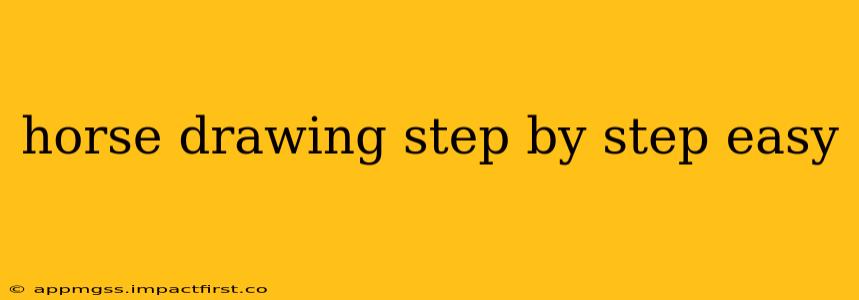Learning to draw a horse can seem daunting, but with a simple step-by-step approach, even beginners can create a recognizable and charming equine portrait. This guide will walk you through the process, focusing on easy techniques to achieve a satisfying result. We'll break down the horse's anatomy into manageable shapes, making the drawing process accessible and enjoyable.
Getting Started: Materials and Preparation
Before we begin, gather your materials. You'll need:
- Paper: Smooth drawing paper is ideal for beginners, as it allows for easier erasing.
- Pencil: A standard HB or 2B pencil will work well. Sharpen it to a fine point for detail work.
- Eraser: A kneaded eraser is excellent for lifting pencil marks without damaging the paper.
- Reference Image (Optional): Having a picture of a horse as a reference can be very helpful, especially when starting out.
Now, let's get started!
Step 1: The Basic Shapes
We'll begin by constructing the horse's body using simple geometric shapes.
-
Circle for the Body: Draw a large circle slightly off-center on your paper. This forms the main body of the horse.
-
Oval for the Neck: Attach an oval shape to the top left of the circle. This oval should be slightly narrower at the end connecting to the head.
-
Small Circle for the Head: Draw a smaller circle at the narrower end of the neck oval. This will be the horse's head.
-
Legs: Rectangles and Ellipses: Sketch four slightly curved rectangles extending downwards from the body circle. These will form the legs. Add ellipses at the bottom of each rectangle to represent the hooves.
Step 2: Refining the Shapes
Now, we'll start refining these basic shapes into a more horse-like form.
-
Smooth the Connections: Gently connect the circles and ovals, smoothing out the harsh lines where they meet.
-
Define the Neck: Refine the neck, giving it a more natural curve.
-
Shape the Head: Add the muzzle, ears (two small triangles on top of the head), and eyes (two small ovals).
-
Leg Details: Refine the legs, making them more slender and adding slight curves to suggest muscle and joint structure. Draw the hooves more clearly.
Step 3: Adding Details
This stage involves adding the finer details to bring your horse drawing to life.
-
Mane and Tail: Draw the mane as a flowing line along the neck, and the tail as a long, flowing shape extending from the rear of the body. Use varying line weights to create a sense of movement and texture.
-
Muscles and Features: Suggest muscle definition by adding subtle curves to the body and legs. Add nostrils to the muzzle and a small mouth line.
-
Refine the Eyes: Add small pupils to the eyes, giving them life and expression.
Step 4: Final Touches
Once you're happy with the details, you can add the final touches.
-
Erase Guidelines: Carefully erase any remaining construction lines, leaving only the final drawing.
-
Shading: Add shading to give your drawing depth and dimension. Consider the light source and use shading to suggest form and volume.
-
Background (Optional): If you wish, add a simple background to enhance your drawing.
What type of horse is easiest to draw?
For beginners, simpler breeds like Quarter Horses or Mustangs are generally easier to draw. Their less ornate features and more straightforward body shapes are more forgiving for those learning the fundamentals of equine anatomy. Focusing on a single, well-lit reference photo is also key to success!
How can I make my horse drawing look more realistic?
The key to realism lies in careful observation of anatomy. Study reference images to understand the proportions, muscle structure, and bone structure of a horse. Pay attention to details such as the way the muscles shift and the way the legs are positioned. Practicing shading techniques to create depth and dimension will also greatly enhance realism. Careful observation and practice are key!
What are some tips for drawing a horse's legs?
Horse legs are complex, but breaking them down into simpler shapes (cylinders and ellipses) helps. Remember the joints – knees bend backward, and hocks (the ankle equivalent) bend forward. Observe how the muscles and tendons subtly shift as the horse moves. Practice drawing legs from different angles to master their proportions and structure.
What are the main mistakes beginners make when drawing horses?
Common beginner mistakes include incorrect proportions (the head too large or small), unnatural postures, and neglecting the details of the musculature and anatomy. Using references and practicing regularly will significantly reduce these errors. Patience and persistence are key to improving.
By following these steps and practicing regularly, you'll soon be creating impressive horse drawings. Remember, practice is key—the more you draw, the better you'll become! Have fun, and happy drawing!
